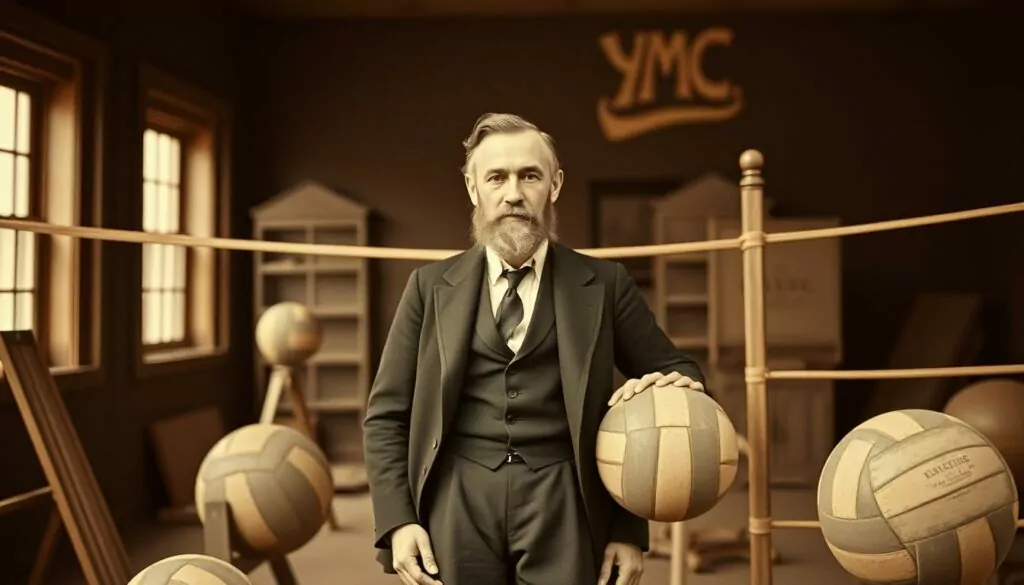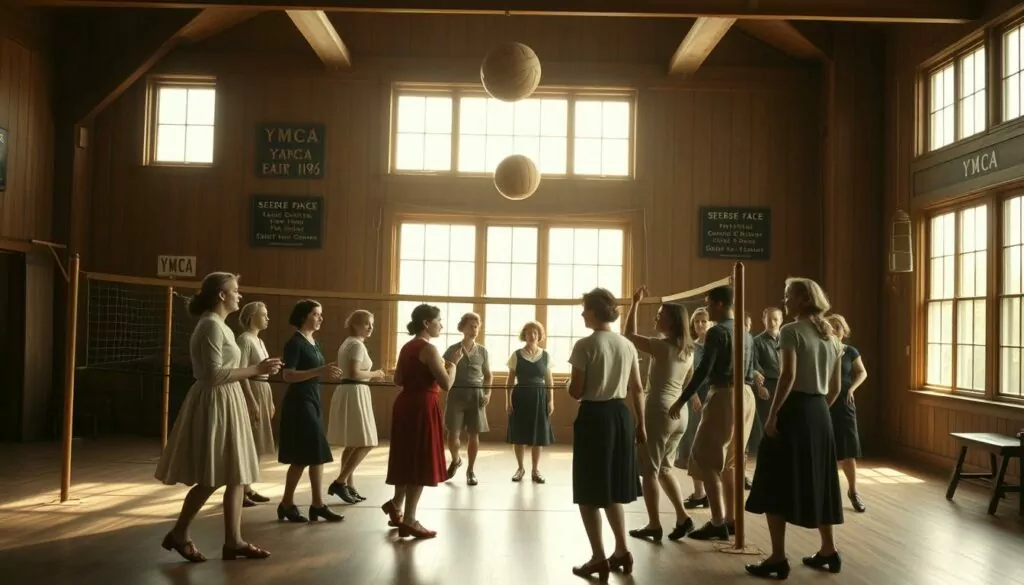Volleyball, now enjoyed by over 800 million people worldwide, started as a gentle alternative to basketball. This fascinating sport began in a YMCA gymnasium. Let’s explore the captivating story of volleyball’s birth and its amazing journey through time.
We’ll uncover the brilliant mind behind volleyball’s creation. We’ll trace its rapid spread from local YMCAs to international arenas. We’ll see how this sport has shaped athletic culture across the globe.
Volleyball’s evolution shows human creativity and sport’s power to unite people. From William Morgan’s innovative idea to today’s modern game, it’s a remarkable journey.
Key Takeaways
- Volleyball was invented as a less strenuous alternative to basketball
- William Morgan created the sport at a YMCA in 1895
- The YMCA played a crucial role in volleyball’s early spread
- Volleyball has grown from a local pastime to an Olympic sport
- The sport has undergone significant rule and equipment changes
- Volleyball now boasts over 800 million players globally
The Birth of Volleyball: From YMCA to Global Phenomenon

Volleyball’s creation is a fascinating tale. In 1895, William Morgan had a brilliant idea at the YMCA. He combined elements of basketball, tennis, and handball to create a new game.
William Morgan’s Innovative Creation
Morgan, a YMCA physical education director, saw a need for a less strenuous alternative to basketball. He raised a tennis net and used a basketball bladder. This simple act gave birth to volleyball.
The YMCA sports program quickly embraced this new game. It offered a fun and engaging activity for their members.
Early Rules and Equipment Development
The original volleyball rules were straightforward. Players could hit the ball back and forth over the net indefinitely. As the game evolved, so did its equipment.
The first volleyball was too heavy for comfortable play. Morgan asked A.G. Spalding & Bros. to create a custom ball that suited the game better.
| Original Volleyball Rules | Modern Rules |
|---|---|
| Unlimited hits per side | Maximum 3 hits per side |
| No player rotation | Mandatory player rotation |
| No set number of players | 6 players per team on court |
YMCA’s Role in Sport Expansion
The YMCA sports program was crucial in volleyball’s growth. They introduced the game to their branches nationwide. By 1896, volleyball had spread to YMCAs across the country.
This rapid expansion set the stage for volleyball’s global journey. It transformed from a local pastime into a beloved worldwide sport.
“Volleyball has given me so much. It’s a game that brings people together, transcending borders and cultures.”
Volleyball History and Origins: Evolution Through Decades

Volleyball has grown from a local game to a global sensation. The sport has evolved constantly, facing new challenges and innovations throughout its history.
This journey has transformed volleyball into an international phenomenon. Each era brought unique changes that shaped the game we know today.
Pre-War Development (1900-1940)
Volleyball spread beyond America in the early 1900s. Canada adopted the sport in 1900, becoming the first foreign country to do so.
By 1913, volleyball reached Asia through the Philippines. The YMCA played a key role in introducing the game to various countries.
Post-War Global Spread (1945-1970)
Volleyball grew rapidly after World War II. The International Volleyball Federation, founded in 1947, became the sport’s governing body.
This organization set standard rules and organized international competitions. These actions pushed volleyball onto the global stage.
Modern Era Transformation (1970-Present)
The modern era brought major rule changes to volleyball. In 1998, the libero position was introduced, changing defensive play.
Beach volleyball began in the 1920s but gained Olympic status in 1996. This marked a new chapter in the sport’s history.
| Era | Key Developments | Impact on Volleyball |
|---|---|---|
| Pre-War (1900-1940) | Global expansion, YMCA influence | Laid foundation for international growth |
| Post-War (1945-1970) | Formation of International Volleyball Federation | Standardized rules, organized competitions |
| Modern (1970-Present) | Introduction of libero, Beach volleyball in Olympics | Enhanced gameplay, increased popularity |
These changes have molded volleyball into a dynamic, globally-loved sport. Volleyball has come a long way from its humble beginnings.
Today, it’s an Olympic favorite, showing its lasting appeal and ability to adapt. The sport’s evolution reflects its ongoing popularity worldwide.
Olympic Journey and International Recognition
Volleyball’s Olympic journey began as a demo in 1924. It became an official Olympic event in 1964, 40 years later. This debut marked a turning point for the sport’s global recognition.
Volleyball has since become a major player on the world stage. International tournaments now attract huge crowds and TV audiences. The FIVB World Championships and World Cup are among the most-watched sporting events.
Professional leagues have emerged worldwide, boosting the sport’s popularity. Italy’s SuperLega and Brazil’s Superliga showcase top talent and inspire new players. The USA’s professional league, launched in 2021, is further growing the sport here.
Volleyball has transformed from a simple YMCA game to an Olympic powerhouse. It’s now one of the most popular team sports globally. The sport’s evolution and ability to captivate audiences continue to impress fans worldwide.

